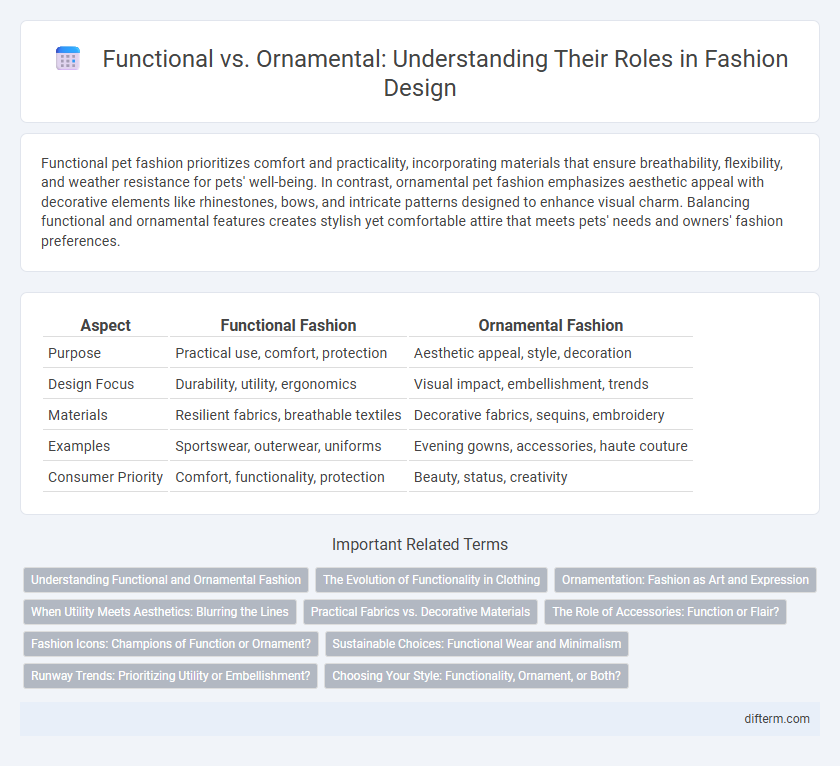Functional pet fashion prioritizes comfort and practicality, incorporating materials that ensure breathability, flexibility, and weather resistance for pets' well-being. In contrast, ornamental pet fashion emphasizes aesthetic appeal with decorative elements like rhinestones, bows, and intricate patterns designed to enhance visual charm. Balancing functional and ornamental features creates stylish yet comfortable attire that meets pets' needs and owners' fashion preferences.
Table of Comparison
| Aspect | Functional Fashion | Ornamental Fashion |
|---|---|---|
| Purpose | Practical use, comfort, protection | Aesthetic appeal, style, decoration |
| Design Focus | Durability, utility, ergonomics | Visual impact, embellishment, trends |
| Materials | Resilient fabrics, breathable textiles | Decorative fabrics, sequins, embroidery |
| Examples | Sportswear, outerwear, uniforms | Evening gowns, accessories, haute couture |
| Consumer Priority | Comfort, functionality, protection | Beauty, status, creativity |
Understanding Functional and Ornamental Fashion
Functional fashion prioritizes practicality and comfort, incorporating materials like moisture-wicking fabrics and ergonomic designs to enhance daily wearability. Ornamental fashion emphasizes aesthetic appeal through decorative elements such as embroidery, sequins, and bold patterns that serve as personal or cultural expression. Understanding the balance between functionality and ornamentation is essential for designers aiming to create garments that are both stylish and purposeful.
The Evolution of Functionality in Clothing
The evolution of functionality in clothing reflects a shift from purely utilitarian designs to garments that balance practicality and aesthetic appeal. Technological advancements in fabrics, such as moisture-wicking and antimicrobial materials, have enhanced comfort and performance without sacrificing style. This blend of function and ornamentation highlights the modern consumer's demand for versatile fashion that meets both everyday needs and personal expression.
Ornamentation: Fashion as Art and Expression
Ornamentation in fashion transforms garments into wearable art by emphasizing aesthetic creativity and personal expression over pure functionality. Intricate embellishments, bold patterns, and unique textures serve as visual storytelling tools that communicate identity, culture, and mood. Designers like Alexander McQueen and Iris van Herpen exemplify this approach, blending craftsmanship with avant-garde artistry to elevate fashion from necessity to expressive masterpiece.
When Utility Meets Aesthetics: Blurring the Lines
Functional fashion emphasizes practicality and comfort through features like moisture-wicking fabrics and ergonomic designs, while ornamental fashion prioritizes visual appeal with intricate patterns and embellishments. When utility meets aesthetics, garments seamlessly integrate performance-enhancing technologies with stylish elements, such as reflective trims on athletic wear or multifunctional accessories that double as fashion statements. This fusion blurs the traditional lines, creating versatile pieces that cater to both everyday functionality and sophisticated style demands.
Practical Fabrics vs. Decorative Materials
Practical fabrics like cotton, wool, and Gore-Tex offer durability, breathability, and moisture-wicking properties essential for everyday wear and active lifestyles. Decorative materials such as sequins, lace, and satin prioritize aesthetics with intricate designs and textures, often sacrificing comfort and functionality. Balancing functional fabrics with ornamental accents allows designers to create garments that are both stylish and wearable.
The Role of Accessories: Function or Flair?
Accessories serve dual purposes in fashion, balancing functionality and aesthetic appeal to enhance both utility and style. Functional accessories like watches, belts, and bags provide practical benefits, while ornamental pieces such as statement jewelry and scarves elevate outfits through visual interest and personal expression. The strategic selection of accessories can transform a look by blending practical needs with artistic flair, defining an individual's unique fashion identity.
Fashion Icons: Champions of Function or Ornament?
Fashion icons like Coco Chanel and Alexander McQueen exemplify the balance between functional and ornamental design, with Chanel prioritizing practical elegance and McQueen embracing bold, artistic embellishments. Their contrasting approaches highlight how functionality in fashion can coexist with ornamental creativity, influencing trends and consumer preferences. This dynamic interplay shapes the evolution of style, blending usability with visual impact to define iconic wardrobes.
Sustainable Choices: Functional Wear and Minimalism
Functional wear in sustainable fashion emphasizes durability, eco-friendly materials, and multi-purpose design to reduce waste and extend garment lifespan. Minimalism complements this approach by encouraging a capsule wardrobe with versatile pieces that prioritize quality over quantity. Consumers adopting these principles support ethical production, lower environmental impact, and timeless style.
Runway Trends: Prioritizing Utility or Embellishment?
Runway trends increasingly blur the line between functional and ornamental fashion, showcasing garments that balance utility with elaborate embellishments. Designers incorporate practical elements like oversized pockets, durable fabrics, and weather-resistant materials while integrating intricate embroidery, beading, and bold patterns to elevate aesthetic appeal. This fusion reflects a shift toward versatile fashion that caters to both everyday functionality and visual impact on the runway.
Choosing Your Style: Functionality, Ornament, or Both?
Choosing your style involves balancing functionality and ornamentation to meet both practical needs and aesthetic goals. Functional fashion emphasizes comfort, durability, and versatility, ideal for daily wear or active lifestyles, while ornamental styles prioritize visual appeal and unique design elements to express personal identity. Integrating both aspects creates a wardrobe that is not only visually striking but also adaptable, enhancing overall confidence and usability.
functional vs ornamental Infographic

 difterm.com
difterm.com